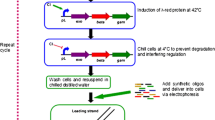Abstract
Industrial biotechnology relies on the availability of highly efficient enzymes and production strains for the development of economically viable processes. Recent advances in the field of genome editing will greatly speed up the implementation of desired metabolic pathways and their optimization, thereby facilitating fast and cost-effective production strain engineering.
Similar content being viewed by others
Literatur
Eggeling L, Bott M, Marienhagen J (2015) Novel screening methods–biosensors. Curr Opin Biotechnol 35:30–36
Kubicek CP (2013) Systems biological approaches towards understanding cellulase production by Trichoderma reesei. J Biotechnol 163:133–142
Copeland NG, Jenkins NA, Court DL (2001) Recombineering: a powerful new tool for mouse functional genomics. Nat Rev Genet 2:769–779
Wang HH, Isaacs FJ, Carr PA et al. (2009) Programming cells by multiplex genome engineering and accelerated evolution. Nature 460:894–898
Gaj T, Gersbach CA, Barbas CF (2013) ZFN, TALEN and CRISPR/Cas-based methods for genome engineering. Trends Biotechnol 31:397–405
Sternberg SH, Redding S, Jinek M et al. (2014) DNA interrogation by the CRISPR RNA-guided endonuclease Cas9. Nature 507:62–67
Mali P, Esvelt KM, Church GM (2013) Cas9 as a versatile tool for engineering biology. Nat Methods 10:957–963
Hsu P, Lander E, Zhang F (2014) Development and applications of CRISPR-Cas9 for genome engineering. Cell 157:1262–1278
Stovicek V, Borodina I, Forster J (2015) CRISPR–Cas system enables fast and simple genome editing of industrial Saccharomyces cerevisiae strains. Metab Eng Commun 2:13–22
Liu R, Chen L, Jiang Y et al. (2015) Efficient genome editing in filamentous fungus Trichoderma reesei using the CRISPR/Cas9 system. Cell Discov 1:15007
Cobb RE, Wang Y, Zhao H (2015) High-efficiency multiplex genome editing of Streptomyces species using an engineered CRISPR/Cas System. ACS Synth Biol 4:723–728
Reis A, Hornblower B, Robb B et al. (2014) CRISPR/Cas9 and targeted genome editing: a new era in molecular biology. NEB Expressions 1:3–6
Author information
Authors and Affiliations
Corresponding author
Additional information
Bastian Blombach, Kathrin Castiglione, Thomas Haarmann und Jochen Schmid (v. l. n. r.) Alle Autoren sind Mitglieder des Zukunftsforums der DECHEMA, in dessen Rahmen diese Publikation verfasst wurde.
Rights and permissions
About this article
Cite this article
Blombach, B., Castiglione, K., Haarmann, T. et al. Trends in der Genomeditierung für die industrielle Biotechnologie. Biospektrum 21, 788–790 (2015). https://doi.org/10.1007/s12268-015-0645-0
Published:
Issue Date:
DOI: https://doi.org/10.1007/s12268-015-0645-0




